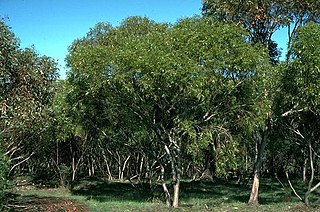
Eucalyptus oraria, commonly known as ooragmandee, is a species of mallee that is endemic to coastal and near-coastal areas of Western Australia. It has smooth greyish bark, sometimes with rough, flaky bark on the base of the trunk, lance-shaped adult leaves, flower buds in groups of nine or more, white flowers and barrel-shaped fruit.

Eucalyptus ligustrina, commonly known as the privet-leaved stringybark, is a species of shrub, mallee or small tree that is endemic to New South Wales. It has rough, stringy bark, lance-shaped to egg-shaped adult leaves, flower buds in groups of between seven and fifteen, white flowers and hemispherical or shortened spherical fruit.

Eucalyptus morrisii, commonly known as grey mallee, is a species of mallee or straggly tree that is endemic to western New South Wales. It has rough, fibrous or flaky bark on some or all of the trunk, smooth greyish bark above, lance-shaped adult leaves, flower buds usually in groups of three, white flowers and conical or hemispherical fruit.

Eucalyptus burracoppinensis, commonly known as Burracoppin mallee is a mallee that is endemic to Western Australia. It has smooth bark, except for a short "stocking" of loose rough bark at the base, lance-shaped adult leaves, flower buds arranged in groups of three, white flowers and top-shaped fruit.
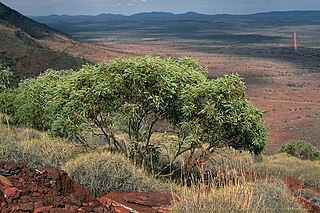
Eucalyptus ewartiana, commonly known as Ewart's mallee, is a species of mallee that is endemic to Western Australia. It has reddish brown, minni ritchi bark, narrow lance-shaped to egg-shaped adult leaves, flower buds in groups of seven, white flowers and conical to hemispherical fruit.

Eucalyptus kessellii, commonly known as Jerdacuttup mallee, is a species of mallee that is endemic to an area along the south coast of Western Australia. It has very hard, rough bark on the trunk of larger specimens, smooth greyish and brownish bark above, lance-shaped to egg-shaped adult leaves, flower buds in groups of three or seven, creamy white flowers and downturned, conical to cup-shaped fruit.

Eucalyptus mannensis, commonly known as Mann Range mallee, is a species of mallee that is native to Western Australia, South Australian and the Northern Territory. It has rough bark at the base of the trunk, smooth bark above, narrow lance-shaped adult leaves, flower buds in groups of between seven and eleven, creamy white flowers and hemispherical fruit.
Eucalyptus neutra, commonly known as the Newdegate mallee, is a species of mallee that is endemic to the south-west of Western Australia. It has greyish bark, lance-shaped adult leaves, flower buds usually in groups of seven, pale yellow to white flowers and barrel-shaped to shortened spherical fruit.
Eucalyptus optima, is a species of small to medium-sized tree or a mallet that is endemic to a small area in the south of Western Australia. It has smooth white to greyish bark, sometimes with rough black bark on the base of the trunk, lance-shaped adult leaves, flower buds in groups of seven or nine, pale yellow flowers and cup-shaped, hemispherical or urn-shaped fruit.
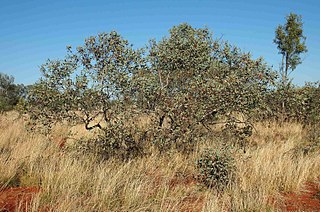
Eucalyptus pachyphylla, commonly known as thick-leaved mallee or the red-budded mallee, is a species of mallee that is native to inland Australia. It has smooth bark, egg-shaped to lance-shaped adult leaves, flower buds in groups of three with five prominent ribs on each bud, and broad, shallow, conical to hemispherical fruit.
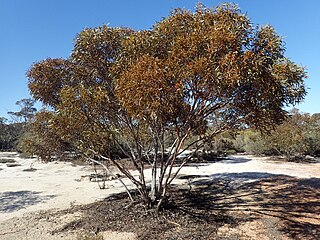
Eucalyptus pileata, commonly known as the capped mallee, is a species of mallee that is native to South Australia and Western Australia. It has smooth greyish bark, narrow lance-shaped adult leaves, flower buds in groups of seven, white flowers and cup-shaped, conical or barrel-shaped fruit.
Eucalyptus quadrans is a species of mallee or a small tree that is endemic to the southwest of Western Australia. It has smooth, greyish bark, narrow lance-shaped adult leaves, flower buds in groups of seven, white flowers and cup-shaped fruit that are square in cross-section.

Eucalyptus rugosa, commonly known as the Kingscote mallee, is a species of mallee that is endemic to coastal areas of southern Western Australia and South Australia. It has smooth bark, lance-shaped adult leaves, flower buds in groups of between seven and thirteen, white flowers and cup-shaped, conical or hemispherical fruit.
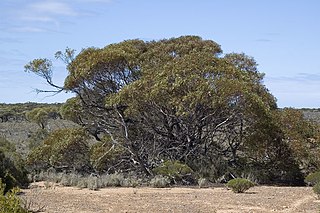
Eucalyptus yalatensis, commonly known as the Yalata mallee, is a species of mallee or a shrub that is endemic to southern Australia. It has rough, fibrous or flaky bark on the stems, smooth bark above, lance-shaped adult leaves, flower buds mostly in groups of nine, creamy white or yellowish flowers and hemispherical to shortened spherical fruit.
Eucalyptus remota, commonly known as the Kangaroo Island ash, Kangaroo Island mallee ash, or Mount Taylor mallee, is a species of tree or mallee that is endemic to Kangaroo Island in South Australia. It has smooth bark, often with rough, fibrous bark on the trunk, lance-shaped adult leaves, flower buds in group of between nine and twenty one, white flowers and hemispherical or shortened spherical fruit.
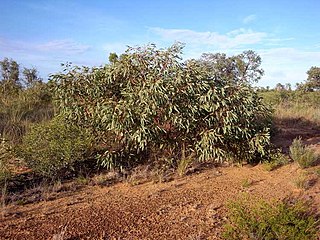
Eucalyptus ammophila, commonly known as the sandplain red gum, is a mallee that is endemic to central and southern Queensland. It has rough fibrous bark near the base and smooth greyish and orange to bronze bark higher up. It has lance-shaped leaves, yellow or creamy flower buds in groups of between seven and eleven, white flowers and hemispherical fruit with strongly raised valves.

Eucalyptus ceratocorys, also known as the horn-capped mallee, is a mallee that is native to South Australia and Western Australia. It has rough, ribbony bark at the base of its trunk, smooth greyish bark above, lance-shaped adult leaves, flower buds in groups of seven or nine with ridges along the sides, white to cream-coloured flowers and cylindrical fruit.
Eucalyptus foliosa is a species of mallee that is endemic to Western Australia. It has a dense crown with foliage reaching to the ground, smooth greyish bark, linear to narrow lance-shaped or narrow oblong adult leaves, flower buds in groups of seven or nine, white flowers and conical to shortened hemispherical fruit. It is only known from a small area near Esperance.
Eucalyptus tephrodes is a species of small tree or mallee that is endemic to Western Australia. It has rough bark on the trunk and larger branches, smooth bark above, egg-shaped to lance-shaped adult leaves, flower buds in groups of three on the ends of branchlets and cup-shaped to hemispherical fruit.

Eucalyptus canescens, commonly known as the Ooldea Range mallee or Beadell's mallee, depending on subspecies, is a species of mallee that is endemic to southern Australia. It has rough bark from the base of the trunk to the thicker branches, smooth bark on the thin branches, egg-shaped to lance-shaped adult leaves, flower buds in groups of between seven and eleven, creamy white flowers and smooth cup-shaped to conical, and sometimes ribbed fruit.















